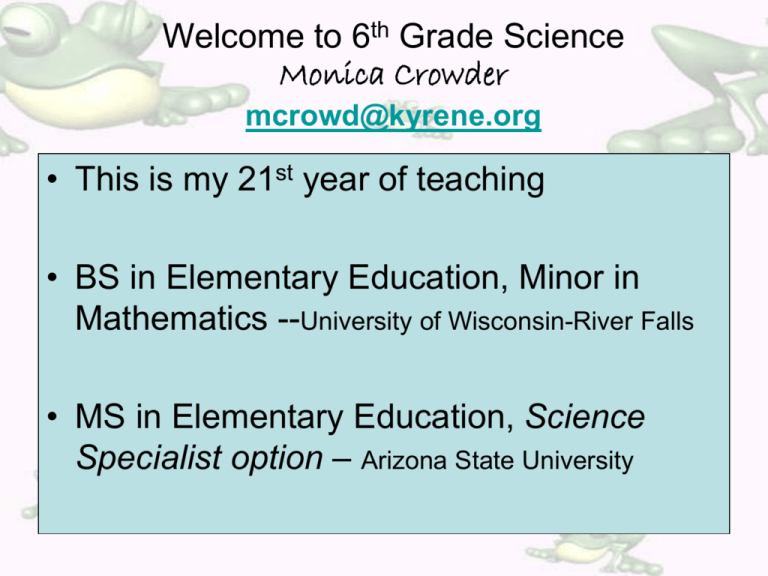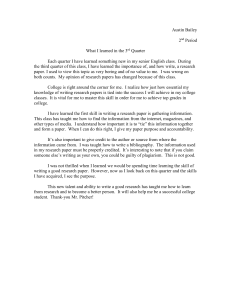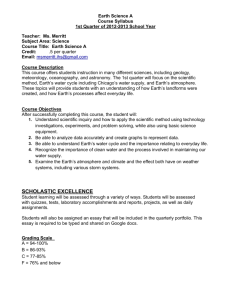7th Grade Science
advertisement

Welcome to 6th Grade Science Monica Crowder mcrowd@kyrene.org • This is my 21st year of teaching • BS in Elementary Education, Minor in Mathematics --University of Wisconsin-River Falls • MS in Elementary Education, Science Specialist option – Arizona State University • How am I graded? – 20% class/home work * – 80% “Assessments” --quizzes/tests/labs Check grades at least once a week *Homework would primarily be completing or “polishing” work from class and studying for exams Students who are absent should check the website or their agendas for details. You receive two days to make up work for each day you are absent. *50% off for late daily class/home work 10% off for each day a project is late. (maximum 3 days) Quarter Unit of Study 1 Beginning of Year Science Skills & Scientific Inquiry 1 Plants 1&2 Human Body Systems 2 Micro Life 3 Energy 4 Earth’s Weather & Atmosphere 4 Our Bioengineered Water Perform accurate measurements Critically analyze media Design a controlled investigation Communicate data, results and information Identify trends Locate and select appropriate resources Keep accurate records Formulate questions based on observations that will lead to a hypothesis and be able to refine a hypothesis Write clear step by step directions Determine validity The Engineering Design Process Identify the Problem Gather Information Imagine Test Plan Build Identify diverse people Major milestones in science and technology Analyze use of technology Apply scientific method Engineering Design Process Lab Safety Metric Measurement First Quarter: Astronomy • Science Process Skills • Scientific Inquiry Plants • Design a controlled experiment • Observe the life cycle of a plant with a Brassica (Wisconsin Fast Plant) • Pollination & dried bee observation lab • Response to stimulus (phototropism,hydrotropism, geotropism) • Plant parts & their functions First Quarter: Astronomy Human Body • • • • respiration – gills, lungs digestion – stomach, intestines circulation – heart, veins, arteries, capillaries locomotion – muscles, skeleton Micro Life • Explain how the human body contracts and fights illnesses and diseases. Cells • Describe the basic structure of a cell • Describe the basic functions of cell parts • Differentiate between plant and animal cells First Quarter: Astronomy Energy • Ways energy can be produced, stored, and transformed • How thermal energy can be transferred- Conduction, Radiation, and Convection • Renewable and nonrenewable energy • Compare the pros and cons of energy sources and the technology behind them. • Conservation • Electrical sources in Arizona Science and it’s impact on society Designing a Renewable Energy Source Solar Ovens Wind Cars Made from repurposed materials Water • Water Cycle • Ocean temperatures, zones, & currents • Lakes & rivers Weather Systems The Earth’s Atmosphere • Describe layers of the atmosphere








